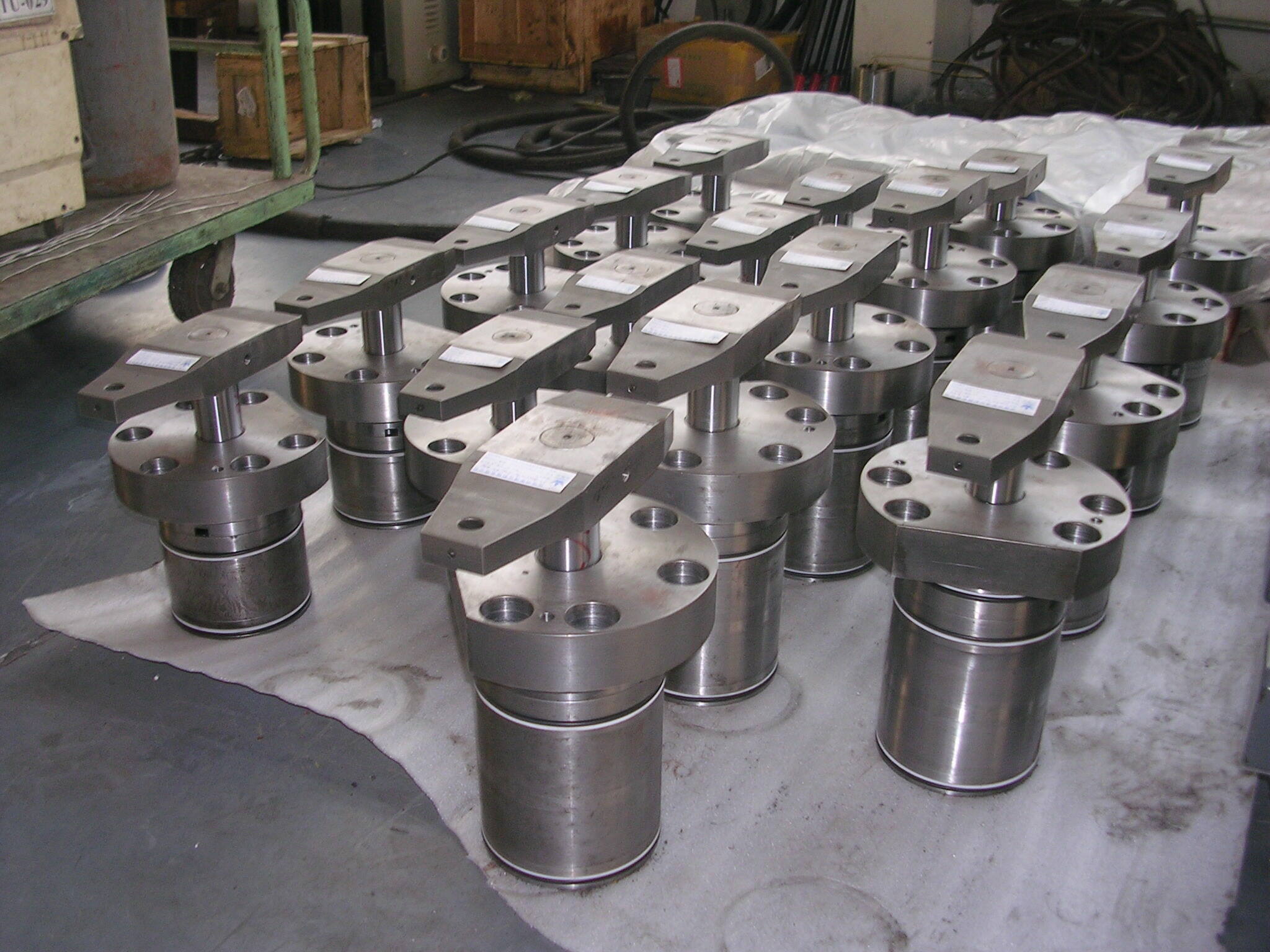유압 매니폴드 기초 이해
핵심 구성 요소와 기능
하이드로릭 매니폴드는 시스템 내 하이드로릭 유체의 흐름과 방향을 제어하는 데 필수적입니다. 밸브, 포트 및 유체 통로와 같은 주요 구성 요소로 이루어져 있으며, 이 요소들이 협력하여 유체의 방향, 압력, 흐름을 관리하게 되며, 다양한 하이드로릭 시스템 응용 분야에 필수적입니다. 이러한 구성 요소 중 하나인 릴리프 밸브는 과도한 압력 상승을 방지함으로써 시스템의 안전성을 확보하는 중요한 역할을 하며, 방향 제어 밸브는 시스템 내 특정 영역으로 유체를 효율적으로 유도하여 작동 기능을 향상시킵니다. 이러한 요소들이 함께 작동함으로써 하이드로릭 시스템은 다양한 상황에서 원활하고 안전하게 작동할 수 있으며, 이는 유체 역학에서의 핵심적인 역할을 보여줍니다.
하이드로릭 매니폴드의 유형: 일체형 회로 대 적층형 설계
하이드로릭 매니폴드는 다양한 작동 요구사항을 충족하도록 설계된 여러 가지 설계 유형이 있습니다. 통합 회로는 여러 기능을 단일 유닛에 소형화하여 효율성을 높이고 유체 저항을 줄이는 시스템으로, 고효율 및 공간 제약이 있는 응용 분야에 이상적입니다. 반면, 적층형 설계는 모듈성을 제공하여 제조업체가 특정 작동 요구사항에 따라 구성 요소를 쌓아 쉽게 커스터마이징할 수 있도록 해줍니다. 각 설계는 고유한 장점을 가지며, 통합 회로는 공간이 협소한 환경에서 선호되는 반면, 적층형 설계는 유연성과 간단한 유지보수가 중요한 응용 분야에 적합합니다. 이러한 다양성 덕분에 하이드로릭 시스템은 각기 다른 작동 요구사항에 효과적으로 맞춤화될 수 있습니다.
콤팩트 하이드로릭 시스템의 역할
공간 효율성 및 유체 분배
유압 매니폴드는 콤팩트한 유압 시스템 내에서 공간 효율을 극대화하는 데 중요한 역할을 합니다. 유압 기능을 중앙 집중화함으로써 이러한 매니폴드는 시스템 전체의 공간 점유를 효과적으로 줄여줍니다. 이는 유압 기능이 여러 구성 요소에 분산되어 있지 않고 공간을 절약할 수 있음을 의미합니다. 매니폴드 내부의 최적화된 유로는 유체 분배를 효과적으로 수행하여 유압 작동유가 최소한의 손실과 저항으로 다양한 구성 요소에 도달할 수 있도록 보장합니다. 연구에 따르면 유압 매니폴드를 사용함으로써 다양한 유압 시스템에 필요한 설치 공간을 최대 30%까지 줄일 수 있습니다. 이는 전체적인 시스템 설계와 기능성을 크게 향상시키므로 현대 유압 장치에서 필수적인 구성 요소로 자리 잡고 있습니다.
통합 밸브로 외부 배관 감소
유압 매니폴드에 통합 밸브를 직접 통합하면 광범위한 외부 배관의 필요성이 최소화됩니다. 이를 통해 더욱 깔끔하고 체계적인 시스템 레이아웃을 구축할 수 있으며, 이는 효율적인 운영에 필수적입니다. 외부 배선 및 연결부 감소는 누출 및 유지보수 문제 발생 가능성도 줄여 유압 시스템의 전반적인 신뢰성을 향상시킵니다. 또한, 밸브를 매니폴드에 통합하면 조립 공정이 간소화되고 제조 비용이 절감됩니다. 이는 효율성과 비용 효율성을 모두 추구하는 현대 유압 시스템의 핵심 요소입니다. 이러한 접근 방식은 외부 배관으로 인해 발생할 수 있는 복잡성을 줄여 설계에 혁신을 가져옵니다.
설계 및 제조 기술
복잡한 유로 가공을 위한 CNC 머시닝
CNC(컴퓨터 수치 제어) 가공은 유압 매니폴드 내부에 복잡한 유로를 제작할 수 있게 함으로써 유압 매니폴드 제작에 혁신을 일으키고 있습니다. 이 정밀 가공 기술은 유로가 유압 유체의 원활한 흐름을 가능하게 하여 유압 프레스 시스템의 효율성과 성능을 높이는 데 기여합니다. 매니폴드를 정확하게 가공함으로써 CNC 가공은 난류와 유체 저항을 줄여 유압 시스템 전반의 효율성을 개선합니다. 또한 제조사들은 CNC 가공을 활용하면 생산 효율성을 최대 25%까지 향상시킬 수 있다고 보고하고 있습니다. 이 증가는 주로 수동 조정의 감소와 자동화된 공정을 통해 달성된 제품 품질의 일관성 덕분입니다.
소재 선택: 알루미늄 대 강철
유압 매니폴드에 적합한 재질을 선택하면 그 성능과 특정 응용 분야에 대한 적합성에 상당한 영향을 미칠 수 있습니다. 알루미늄은 가벼우면서도 부식에 강한 특성으로 인해 이러한 특성이 뚜렷한 이점을 제공하는 응용 분야에서 자주 사용됩니다. 반면, 강철은 뛰어난 강도와 내구성을 자랑하며, 유압잭이 고압을 받는 중작업 응용 분야에 이상적입니다. 알루미늄과 강철 중 어느 것을 선택할지는 각 응용 분야의 구체적인 요구 사항과 환경 조건을 이해하는 데 달려 있으며, 각 재질이 가진 고유한 장단점을 모두 고려해야 합니다.
다양한 산업 분야에서의 적용
건설 장비 (유압 프레스 및 실린더 통합)
하이드로릭 매니폴드는 건설 장비에서 핵심적인 역할을 하며, 큰 힘이 필요한 작업에 필수적인 하이드로릭 프레스 및 실린더와의 시스템 통합을 가능하게 합니다. 이러한 시스템은 중량물의 상하 작동과 같이 건설 현장에서 시간과 정확성이 중요한 생산성 요소인 경우에 특히 효율적인 제어 기능을 제공하도록 설계되었습니다. 하이드로릭 시스템의 견고한 구조는 안전 기준을 높여주고 전반적인 작업 효율성을 개선하여 핵심 작업이 정확하고 일관되게 수행될 수 있도록 보장합니다.
자동차 시스템: 리프트 및 중량 작업 응용 분야
하이드로릭 매니폴드는 자동차 산업에서 특히 차량 정비 및 유지보수에 사용되는 하이드로릭 리프트와 같은 응용 분야에서 필수적입니다. 이는 중량물 운반에 필요한 동력을 제공함으로써 제조 및 수리 공정 모두에서 중역 작업을 가능하게 합니다. 자동차 시스템에 하이드로릭 매니폴드를 통합하면 제어성과 반응성을 향상시켜 사용자 경험과 운영 안전성을 높여줍니다. 이러한 통합은 고압 작업의 원활한 처리를 보장하여 자동차 시스템의 신뢰성과 효율성에 기여합니다.
정밀 제어를 위한 산업용 자동화
산업 자동화는 정밀한 기계 및 로봇 팔 작동을 위해 유압 매니폴드에 크게 의존하며, 이는 제조 공정에서 핵심적인 역할을 합니다. 이러한 매니폴드는 동기화된 작동을 가능하게 하여 복잡한 작업을 높은 정확도로 수행할 수 있도록 하며, 이로 인해 생산성과 제품 품질이 향상됩니다. 유압 기술의 지속적인 발전에 따라 매니폴드 시스템을 통합하면 공정을 간소화하고 다운타임을 최소화함으로써 운영 비용을 크게 절감할 수 있습니다. 효율성의 이러한 개선은 현대 산업 환경에서 경쟁 우위를 유지하는 데 매우 중요합니다.
유압 매니폴드 솔루션의 장점
누유 감소 및 유지보수 효율성
하이드로릭 매니폴드의 주요 이점 중 하나는 외부 연결 부위를 줄이고 설계를 최적화함으로써 누유를 크게 줄일 수 있다는 것입니다. 이러한 간결한 설계는 잠재적인 약점들을 최소화하여 누유 발생을 대폭 줄이고, 시스템의 신뢰성과 수명을 향상시킵니다. 하이드로릭 매니폴드를 도입하면 누유 및 고장으로 인한 수리 필요성이 감소함에 따라 유지보수 비용을 최대 40%까지 절감할 수 있다는 추정치도 있습니다. 또한 이러한 매니폴드의 콤팩트한 구조는 정기 유지보수를 단순화하여 접근과 고장 진단을 보다 용이하게 합니다. 이러한 접근성은 운영 효율성을 유지하고 장비가 자주 중단되지 않고 작동할 수 있도록 보장하는 데 매우 중요합니다.
콤팩트 레이아웃에서의 에너지 최적화
유압 매니폴드는 배관 길이를 최소화하여 시스템 내 유체 이동에 필요한 에너지를 절감함으로써 에너지 최적화에 기여합니다. 이러한 배관 감소는 에너지 효율을 향상시킬 뿐만 아니라 시스템 설계를 간소화하여 더욱 컴팩트하고 관리하기 쉽게 만듭니다. 연구에 따르면 유압 매니폴드를 통해 컴팩트한 레이아웃을 구현하면 유압 시스템의 에너지를 최대 15%까지 절감할 수 있습니다. 이는 유압 매니폴드 솔루션을 도입하는 산업의 운영 비용 절감으로 이어집니다. 또한, 효율적인 에너지 소비는 환경적 책임을 중시하는 업계 동향에 발맞춰 지속 가능한 제조 관행을 직접적으로 지원합니다. 매니폴드의 설계는 폐기물 및 자원 소비 감소에 기여하여 현대적인 생태 공학 솔루션에서 그 역할을 더욱 강화합니다.


